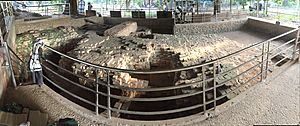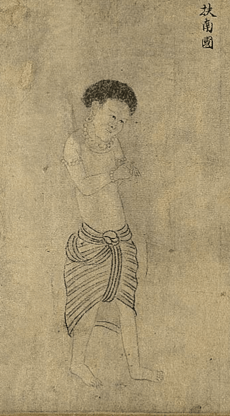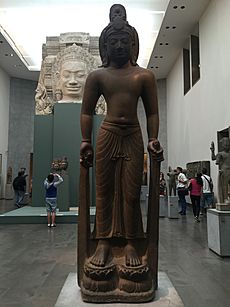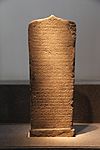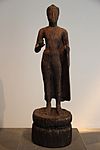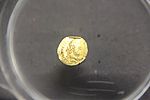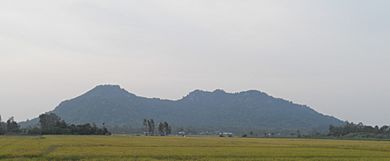Funan facts for kids
Quick facts for kids
Funan
|
|||||||
|---|---|---|---|---|---|---|---|
| 68–627 | |||||||
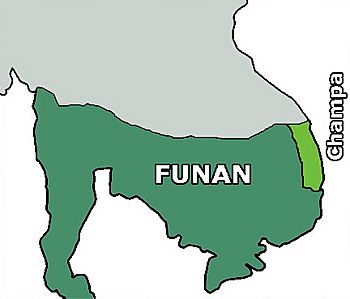 |
|||||||
| Capital | Vyādhapūra | ||||||
| Common languages | Proto-Khmer (common), Sanskrit (religious) | ||||||
| Religion | Hinduism, Buddhism and Khmer Animism | ||||||
| Government | Monarchy | ||||||
| Historical era | Classical Antiquity | ||||||
|
• Established
|
68 | ||||||
|
• Disestablished
|
627 | ||||||
| Currency | Native coins | ||||||
|
|||||||
| Today part of | |||||||
Funan was an ancient kingdom in Southeast Asia. It existed from the 1st to the 6th century CE. Chinese writers gave it the name "Funan." This kingdom was located around the Mekong Delta, which is now part of Cambodia, Thailand, and Vietnam.
Funan was not just one big country. It was more like a group of smaller states that worked together. Chinese diplomats, Kang Tai and Zhu Ying, visited Funan in the 3rd century. Their reports tell us most of what we know about it.
In the local languages, Funan was called Nokor Phnom, which means "Mountain Kingdom." However, the people of Funan themselves did not use the name "Funan." We don't know what they called their own kingdom.
Historians are still discussing what language the Funanese people spoke. Some think they spoke an early form of Khmer. Others believe they spoke Austronesian languages. It's also possible that many different groups of people lived there.
Archaeological digs show that people lived in the Mekong Delta as early as 400 BCE. Funan became a powerful trading state. Goods from the Roman Empire, China, and India have been found at ancient trading centers like Óc Eo in Vietnam.
Contents
What Does "Funan" Mean?
The name "Funan" comes from Chinese writings. Scholars believe it might be a Chinese way of writing a local word.
One idea is that "Funan" sounds like the Khmer word phnom, which means "mountain." So, it could mean "Mountain Kingdom."
However, other experts disagree. They point out that the Chinese word for "South" is nan. So, "Funan" might just mean "Southern Region" in Chinese. It might not be a local word at all.
Because of this, some scholars prefer to use names found in local inscriptions. These names include Bhavapura or Vyadhapura. These names give us a clearer idea of the ancient cities in the region.
History of Funan
How Funan Started
Chinese stories say that a foreigner named Huntian founded Funan around the 1st century CE. He came from a southern country. A dream told him to sail to Funan.
When he arrived, the local queen, Liǔyè (also known as Queen Soma), tried to attack his ship. Huntian shot an arrow from his magic bow. It hit her ship, and she got scared. She then married Huntian. He taught her to wear clothes and became the king.
This story is similar to a Khmer legend. In that story, a prince named Preah Thaong marries a snake princess named Neang Neak. This myth shows how Indian culture mixed with local beliefs.
Archaeological findings show that people lived in the Mekong Delta long before Funan officially started. Funan might have been a group of city-states that sometimes fought and sometimes united.
The people of Funan were likely a mix of different ethnic groups. Some historians think they were mostly Khmer people. Others believe they were Austronesian. It's also possible that Funan was a multicultural society.
Indian culture became more important in Funan over time. This happened through trade and the arrival of scholars from India. The official language for important writings was Sanskrit, an Indian language.
Funan's Golden Age and Decline
Funan became very powerful under King Fan Shiman in the 3rd century. He built a strong navy and improved the government. His kingdom controlled a large area.
Funan was known for its trade. It sent ambassadors to China and India to help with sea trade. This helped spread Indian culture across Southeast Asia. Funan also had a strong system of trade and business.
Funan's success depended a lot on sea trade. Its ports were important stops for ships traveling between India and China. However, changes in trade routes led to its decline. New trade centers appeared in other places, like Sumatra. China also started controlling more trade routes. This made Funan's economy weaker.
In the 6th century, a kingdom called Chenla grew stronger to the north. Chenla was a Khmer kingdom. It eventually took over Funan. The last known king of Funan was Rudravarman, who ruled until about 545 CE.
After Funan fell, the first writings in the Khmer language appeared. Many historians believe that the people of Funan were mostly Khmer.
Life in Funan
We don't have many written records from Funan itself. Most of what we know comes from Chinese writings and archaeological discoveries.
Archaeologists have found old brick buildings, precious metals, and pottery. They also found a large system of canals. These canals connected cities like Angkor Borei to the coast. This shows that Funan had a well-organized government. It was a complex society with many people and advanced technology.
Capital Cities
Historians have different ideas about where Funan's capital city was.
- One idea is that the capital was near Ba Phnom in modern Cambodia. This is based on the idea that "Funan" means "mountain."
- Another idea is that the capital was a city called "Vyādhapura," meaning "City of the Hunter."
Archaeological work has been done in southern Cambodia and Vietnam. At Angkor Borei, researchers found ancient burials and many old structures. They also found a large canal system connecting Angkor Borei to the trading port of Óc Eo.
Many ancient sites in the region show signs of continuous human activity for over 2,000 years. This suggests that these areas were important for a long time. Angkor Borei might have been the main capital of Funan for much of its history.
Culture and Daily Life
Funanese culture was a mix of local traditions and Indian ideas. Indian culture had a big impact. Sanskrit was used in the royal court. People in Funan practiced Hinduism and later Buddhism.
Chinese records say that Funanese people lived in houses built on stilts. They grew rice and paid taxes in gold, silver, pearls, and perfumes. They also had books and archives, showing they valued learning.
The Chinese also reported that Funanese musicians visited China in 263 CE. The Chinese emperor was so impressed that he created a special school for Funanese music.
Two Buddhist monks from Funan, Mandrasena and Sanghapala, lived in China in the 5th and 6th centuries. They translated many Buddhist texts from Sanskrit into Chinese.
Economy and Trade
Funan was the first major economy in Southeast Asia. It became rich through sea trade and farming. The kingdom even made its own silver coins, which had a picture of a crested argus bird.
Funan was located on an important trade route between India and China. Ships would sail from India to the Malay Peninsula. Then, goods would be carried across the land. After that, they would be loaded onto ships again to sail along the coast to China. Funan controlled parts of this important route.
The trading port of Óc Eo was a key stop on this international route. Archaeologists have found Roman, Persian, Indian, and Greek artifacts there. Some scholars believe Óc Eo was the ancient port of Kattigara. This was a place where merchants from the Roman and Chinese empires met to trade.
Roman coins have been found at Óc Eo. These include gold medallions from the 2nd century CE. Local people in Funan also made their own gold copies of Roman coins. This suggests that traders from the Roman Empire might have brought minting techniques to Funan.
Besides trade, Funan also had a smart farming system. They used canals and water storage to grow rice. Most of the people lived along the rivers of the Mekong Delta, which was perfect for fishing and rice farming.
Rulers of Funan
| Order | Sanskrit Name | Names in Chinese Texts | Reign |
| 01 | Neang Neak (Queen Soma) | Liǔyè (柳葉) | 1st/2nd century? |
| 02 | Preah Thong | Hùntián (混塡) / Hùnhuì (混湏) | 1st/2nd century |
| 03 | Hun Pan-huang | Hùnpánkuàng (混盤況) | 2nd century |
| 04 | Pan-Pan | Pánpán (盤盤) | late 2nd century |
| 05 | Srei Meara | Fàn Shīmàn (范師蔓) | early 3rd century |
| 06 | Unknown | Fàn Jīnshēng (范金生) | c. 230? |
| 07 | Unknown | Fàn Zhān (范旃) | c. 230 – c. 243 or later |
| 08 | Unknown | Fàn Cháng (范長) | after 243 |
| 09 | Unknown | Fàn Xún (范尋) | 245/50-287 |
| 10 | Unknown | Unknown | 4th century |
| 11 | Candana | Zhāntán (旃檀) | c. 357 |
| 12 | Unknown | Unknown | Unknown |
| 13 | Kaundinya | Qiáochénrú (僑陳如) | c. 420 |
| 14 | Sri Indravarman I | Chílítuóbámó (持梨陀跋摩) | c. 430 – c. 440 |
| 15 | Unknown | Unknown | Unknown |
| 16 | Unknown | Unknown | Unknown |
| 17 | Jayavarman Kaundinya | Qiáochénrú Shéyébámó (僑陳如闍耶跋摩) | 484–514 |
| 18 | Rudravarman | Liútuóbámó (留陁跋摩) | 514-c.545 |
Images for kids
See also
 In Spanish: Reino de Funan para niños
In Spanish: Reino de Funan para niños


